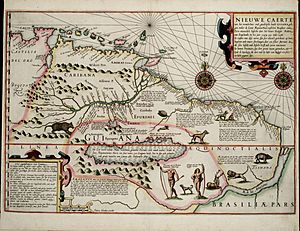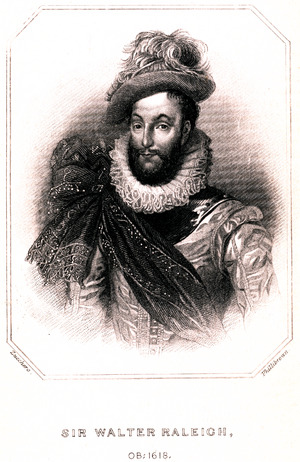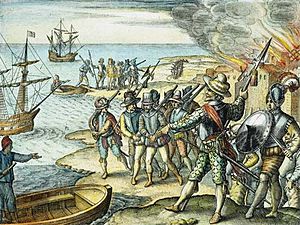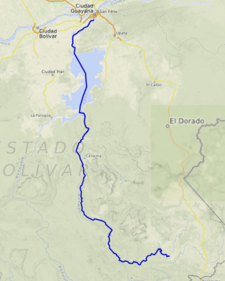Raleigh's El Dorado expedition facts for kids
Quick facts for kids Raleigh's El Dorado Expedition |
|||||||
|---|---|---|---|---|---|---|---|
| Part of the Anglo-Spanish War | |||||||
 Map from 1599, made as a result of the expedition showing the supposed Lake Parime with Manoa on its northeastern shore |
|||||||
|
|||||||
| Belligerents | |||||||
| Commanders and leaders | |||||||
The Raleigh's El Dorado expedition, also known as Raleigh's first voyage to Guiana, was an English journey led by Sir Walter Raleigh in 1595. It happened during the Anglo-Spanish War. The main goal was to explore the Orinoco River in South America. Raleigh hoped to find the legendary golden city of El Dorado.
First, Raleigh captured the Spanish town of San José de Oruña on the island of Trinidad. He also captured its governor, Antonio de Berrío, who was also searching for El Dorado. Raleigh used the town as a base. Even with Spanish forces nearby, Raleigh explored the river. He traveled about 400 miles (640 km) into the Guiana highlands.
Raleigh did not find gold or the lost city. However, he returned to England and made his story sound more exciting. The trip also helped form an important friendship with the local native people. This friendship would be important for future English plans in the area.
Contents
Why Raleigh Explored Guiana

England and Spain were at war in 1585. English ships often attacked Spanish and Portuguese towns and ships. Sir Walter Raleigh was a favorite of Queen Elizabeth I. He had been famous for his sea adventures.
Raleigh wanted to regain the Queen's favor. He promised to find a "gold-rich empire" even better than Peru. He planned an expedition to find the famous city of gold, El Dorado. Raleigh believed it was near Lake Parime in the highlands of Guyana.
Raleigh became interested in El Dorado after capturing Pedro Sarmiento de Gamboa in 1586. Gamboa was a Spanish governor. He shared his maps with English mapmakers. Gamboa told a story about a man named Juan Martinez. Martinez claimed he was taken to a golden city while blindfolded. He said he was entertained by the natives. He remembered a large lake nearby. Raleigh thought this city was Manoa, near a lake called Parime. He also wanted England to have a presence in South America. He hoped to stop trade between the native people and the Spanish.
In 1594, Raleigh sent John Whiddon to Trinidad. The Spanish governor, Antonio de Berrío, was there. De Berrío was also looking for El Dorado. He ordered Whiddon's small group to be killed. But Whiddon was allowed to leave and tell Raleigh what happened. Raleigh quickly planned his own trip. His first goal was to capture de Berrío.
Raleigh's expedition had four ships. These included the Lion's Whelp and Raleigh's own flagship. About 150 soldiers and volunteers joined him. Two other English expeditions were also in the area.
The Journey Begins
Raleigh left Plymouth, England, on February 6, 1595. He sailed to the Azores for supplies. Then he crossed the Atlantic Ocean. Near the Canary Islands, he captured a Spanish ship. He took many firearms from it. The next day, he captured a Flemish ship and took its wine.
Raleigh reached the Caribbean in late March. He had lost contact with his other ships. The other English expeditions had also missed their meeting with Raleigh. They continued their own missions. They attacked Spanish towns like La Guaira and Coro. They even captured Caracas.
Capturing Trinidad Island

Raleigh planned to attack the Spanish colony on Trinidad. His target was San José de Oruña, founded by Berrio in 1592. First, Raleigh explored the south of the island. He saw that the native people grew good tobacco and sugar cane.
While sailing, he smelled tar. He landed at Terra de Brea. The local Carib people showed him a pitch lake. This was the world's largest natural asphalt lake. Raleigh realized it was perfect for sealing his ships. He took several barrels of it. He is often given credit for "discovering" the lake.
Raleigh's main goal was to capture the Spanish governor, de Berrío. He wanted to question him about El Dorado. On April 4, Raleigh landed 100 soldiers. They quickly took the small fort at Puerto de España. They then moved inland to capture San José de Oruña. They launched a surprise night attack. The battle lasted less than an hour. Almost 50 Spanish soldiers were killed.
The Spanish general, Alvaro Jorge, was captured. But the most important capture was Governor de Berrío. De Berrío asked Raleigh to spare the town. Raleigh agreed. He used San José as a temporary base to explore the Orinoco River. Raleigh also freed five native chiefs. De Berrío had chained, tortured, and starved them.
The English built a fort to protect against Spanish attacks. Raleigh questioned de Berrío about Manoa and El Dorado. De Berrío tried to stop Raleigh from continuing. But his warnings did not work.
Exploring the Orinoco River
On April 15, 1595, Raleigh left his base. He used the Gallego ship, which was made smaller for river travel. He had 100 men and enough food for almost a month. They had to leave quickly. They heard rumors of a large Spanish expedition coming.
The rumor was true. A Spanish force led by Captain Felipe de Santiago set out from Margarita Island. They tried to follow Raleigh's group. The English entered the Orinoco River. The water was sometimes too shallow. So, the Gallego was changed even more. They also built rafts to lighten the load.
As they went deeper into the river, many small waterways appeared. Raleigh and his men first traveled down the Manamo river. The expedition began to suffer from the heat and tropical rains. The jungle became very thick. The crew had to cut their way through. Some men got lost, including a native guide named Ferdinando.
Raleigh soon found a native village. They got a new guide, fish, bread, and fowl. He set off again. The jungle became less dense. Within a few days, the savanna country of the Orinoco valley appeared. Everyone's spirits lifted. One man, a Black crew member, decided to swim. He was eaten by an crocodile right in front of everyone. Raleigh was horrified. He saw that the river was full of these reptiles. He ordered his crew not to take any risks.
Spanish Surprise Attack
On April 27, the Spanish under Santiago tried to surprise the English. The English rear group had separated to get fresh water. The Spanish sent four canoes. They tried to sneak up on the English. But they got stuck in a narrow channel.
The English were surprised but quickly fought back. Gifford and his boats launched a counterattack. They defeated the Spanish. The Spanish had many casualties, while the English had none. The remaining Spanish fled into the woods. Gifford took their boats as prizes. Raleigh and the other boats heard the shots. They forced the last two Spanish canoes to disappear. Raleigh sent a small group to chase the Spanish. They caught three native people. The natives thought they were Spanish. They begged for their lives. One of them agreed to be their guide.
After this defeat, Santiago gave up. He returned to Margarita Island. The captured Spanish canoes had much-needed food and supplies. They also found tools for finding different types of ores.
Caroni River to Mount Roraima
A day later, Raleigh's expedition reached a large river meeting point. This was the Caroni River. Here, Raleigh met the local Amerindian people. These included the Warao people and the Pemons. The English showed their victory over the Spanish by presenting a captured Spanish canoe. They successfully made peaceful friends with them.
They found a large village, possibly near modern-day Ciudad Guayana. It was ruled by an old chief named Topiawari. Raleigh became friends by saying he was an enemy of the Spanish. The native people widely disliked the Spanish. Topiawari told Raleigh about a rich culture living in the mountains. Raleigh easily believed this was the rich Inca culture of Peru. He thought it must be the famous city of Manoa.
Raleigh left two of his men as hostages. In return, Raleigh took Topiawari's son. This formed an alliance against the Spanish. Some of the ships stayed at the village to get supplies for the trip home. Raleigh and Kemys continued with Topiawari's son as a guide. They went up the Caroní River. They sent out scouts to look for gold and mines. They also made alliances with any native people they met. His scouts brought back rocks. They hoped these rocks would contain gold.
As they went further, Raleigh noticed a change in the land. He described a tepuy (table-top mountain). He saw and recorded the largest, Mount Roraima. Its top is 31 square kilometers. It is surrounded by cliffs rising 400 meters. Raleigh also saw about twelve waterfalls. He noted the largest was "higher than any church spire." They got off their boats and walked to see it closer. He described the area as the most beautiful he had ever seen. Some people think Raleigh might have been the first European to see Angel Falls. However, these claims are not widely accepted.
By this time, the expedition had traveled almost 400 miles (640 km) inland. The rainy season had begun. Raleigh decided he had explored enough. He gave the order to turn back. They returned to Topiawari's village. Topiawari's son agreed to go back to England with Raleigh. Raleigh named him Gualtero.
After joining the rest of the crew, Raleigh set off for Trinidad. On his way, he learned about a gold mine near Mount Iconuri from a native chief. He sent Lawrence Keymis with a small group to investigate. Keymis got close to the place, which was near Santo Tomas. He saw a large waterfall (today Llovizna Falls). He did not see the mine itself. But he saw good quality quartz rock. He believed the place was valuable.
Returning to Trinidad
Raleigh returned to San Jose. Amazingly, he had lost no men to disease, except for the crocodile attack. His crew was quite healthy. This was partly because of the native diet. When he arrived at the fort, they decided to return to England. But first, they took everything valuable from the fort. Then they burned it down, despite de Berrío's protests.
Raleigh landed on Margarita Island. He successfully took supplies. Then he landed at the port of Cumaná. He left de Berrío there because he could not get a ransom for him. Finally, Raleigh attacked Riohacha. He also looted and plundered it.
On July 13, Raleigh finally met up with Preston and Somers. They told him about their amazing attacks on Caracas, La Guaira, and Coro. Strong winds forced them to give up the idea of visiting the colony of Roanoke. All of them arrived back in England by the end of August 1595.
After the Expedition
Raleigh arrived in England. But he did not receive much praise. Cecil, who had invested a lot, was disappointed there was no gold. A London official examined the rocks Raleigh brought back. He said they were worthless, even though they had some gold. Others accused Raleigh of hiding gold in England. Raleigh was very angry about these claims. He decided to write a book about his trip. It was called The Discovery of rich and beautiful empire of Guiana. This book made the region sound much grander than it was.
Despite this, the book became popular in England, France, and the Netherlands. Raleigh sent Kemys back to Guyana the next year. Kemys was to check on the hostages and renew the alliance with the native people. He also needed to map the Orinoco River. He was to record the native tribes and make reports about the country's geography, geology, and plants. This time, Kemys went much further inland along the Essequibo River. He reached what he wrongly thought was Lake Parime. He wrote a detailed account of the Guiana coast in his book, Relation of the Second Voyage to Guiana.
The same year, de Berrío also led a Spanish expedition. He had 470 men. They also searched for El Dorado. But as they went inland, the native people, now allied with England, attacked them. They destroyed de Berrío's force, losing 350 men. The rest tried to retreat. But disease and hunger reduced the survivors to only a few.
After being released from prison by King James I in 1617, Raleigh returned for a second expedition. He still wanted to find El Dorado. He was told to avoid fighting with the Spanish. With Kemys and his son, Watt Raleigh, they searched for the gold mine at Mount Iconuri. However, Raleigh was sick. He stayed behind in a camp on the island of Trinidad. Kemys went up the Orinoco River. Watt was killed in a battle with the Spanish. They destroyed and looted the Spanish settlement at Santo Tome de Guayana.
Kemys told Raleigh about the disaster and his son's death in a letter. He went to Raleigh to ask for forgiveness. But Raleigh could not forgive him. Raleigh said, "I told him that he had undone me by his obstinacy, and that I would not favour... in any sort his former follie". Kemys reportedly replied, "I know then, Sir, what course to take," before returning to his own cabin. When Raleigh returned to England, King James ordered him to be executed. This was for disobeying orders to avoid conflict with the Spanish. He was executed in 1618.
In 1713, Spain and Great Britain signed the Treaty of Utrecht. The British agreed to stop their citizens from visiting Spanish colonies without permission. The native people were aggressive towards the Spanish. So, the Spanish never returned to the region in force. This allowed other European countries like France, Britain, and the Dutch Republic to start colonies there. These became Dutch Guyana, French Guiana, and British Guyana. By the early 1800s, explorers proved that Lake Parime did not exist. Some thought that seasonal flooding of the Rupununi savannah had been mistaken for a lake.
The gold mine at El Callao (Venezuela) started in 1871. It was a few miles south of the Orinoco River. For a time, it was one of the richest in the world. Over a million ounces of gold were exported between 1860 and 1883. Most immigrants to these gold mines were from the British Isles and the British West Indies.
The Orinoco Mining Arc (OMA) was created on February 24, 2016. It is an area rich in minerals in Venezuela. It has 7,000 tons of gold, copper, diamond, coltan, iron, bauxite, and other minerals.
Legacy and Impact
- In 1953, Trinidad and Tobago issued a postage stamp. It showed the Discovery of Lake Asphalt by Raleigh, 1595.
- In 1976, the Republic of Guyana issued a 100-dollar gold coin. It honored the book Discovery of Guiana 1596 and 10 years of independence from British Rule.




